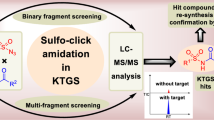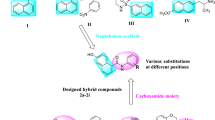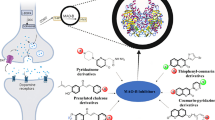Abstract
A series of novel isatin-linked 4,4-dimethyl-5-methylene-4,5-dihydrothiazole-2-thiols (IT2Ts) 1a–1g were designed as acetylcholinesterase (AChE) inhibitors capable of interacting with both the catalytic active site (CAS) and peripheral anionic site (PAS) of the enzyme simultaneously. The target IT2Ts were prepared through a short synthesis in moderate yield. The most potent inhibitors of this series 1b and 1c (IC50 = 18.2 and 27.5 μM, respectively) outperformed rivastigmine and were comparable to galantamine, both clinically used AChE inhibitors. Furthermore, 1b displayed non-competitive inhibition patterns in kinetic studies, whereas molecular modeling predicted a simultaneous interaction with both the CAS and PAS. In silico methods predicted several promising drug-like characteristics of 1b. Taken together, these results indicate 1b warrants further investigation as a multitarget-directed ligand for AChE inhibition.








Similar content being viewed by others
References
Talita HF-V, Isabella MG, Flavia RS, Fabiola MR. Alzheimer’s disease: targeting the cholinergic system. Curr Neuropharmacol. 2016;14:101–15. https://doi.org/10.2174/1570159X13666150716165726.
Perez-Lloret S, Barrantes FJ. Deficits in cholinergic neurotransmission and their clinical correlates in Parkinson’s disease. npj Parkinson Dis. 2016;2:16001 https://doi.org/10.1038/npjparkd.2016.1.
Evoli A. Myasthenia gravis: new developments in research and treatment. Curr Opin Neurol. 2017;30:464–70.
Alzheimer’s Association Report. 2021 Alzheimer’s disease facts and figures. Alzheimer Dementia. 2021;17:327–406. https://doi.org/10.1002/alz.12328.
Davies P, Maloney AJF. Selective loss of central cholinergic neurons in Alzheimer’s disease. Lancet. 1976;308:1403 https://doi.org/10.1016/S0140-6736(76)91936-X.
Craig LA, Hong NS, McDonald RJ. Revisiting the cholinergic hypothesis in the development of Alzheimer’s disease. Neurosci Biobehav Rev. 2011;35:1397–409. https://doi.org/10.1016/j.neubiorev.2011.03.001
Hardy JA, Higgins GA. Alzheimer’s disease: the amyloid cascade hypothesis. Science. 1992;256:184 https://doi.org/10.1126/science.1566067.
Kurz A, Perneczky R. Amyloid clearance as a treatment target against Alzheimer’s disease. J Alzheimer Dis. 2011;24:61–73. https://doi.org/10.3233/JAD-2011-102139.
Ittner LM, Götz J. Amyloid-β and tau — a toxic pas de deux in Alzheimer’s disease. Nat Rev Neurosci. 2011;12:67–72. https://doi.org/10.1038/nrn2967.
Savelieff MG, Lee S, Liu Y, Lim MH. Untangling amyloid-β, tau, and metals in Alzheimer’s disease. ACS Chem Biol. 2013;8:856–65. https://doi.org/10.1021/cb400080f.
Zündorf G, Reiser G. Calcium dysregulation and homeostasis of neural calcium in the molecular mechanisms of neurodegenerative diseases provide multiple targets for neuroprotection. Antioxid Redox Signal. 2010;14:1275–88. https://doi.org/10.1089/ars.2010.3359
Quintanilla RA, Orellana JA, von Bernhardi R. Understanding risk factors for Alzheimer’s disease: Interplay of neuroinflammation, connexin-based communication and oxidative stress. Arch Med Res. 2012;43:632–44. https://doi.org/10.1016/j.arcmed.2012.10.016.
Swerdlow RH, Burns JM, Khan SM. The Alzheimer’s disease mitochondrial cascade hypothesis: progress and perspectives. Biochim Biophys Acta. 2014;1842:1219–31. https://doi.org/10.1016/j.bbadis.2013.09.010.
Schliebs R, Arendt T. The significance of the cholinergic system in the brain during aging and in Alzheimer’s disease. J Neural Transm. 2006;113:1625–44. https://doi.org/10.1007/s00702-006-0579-2.
Dhillon S. Rivastigmine transdermal patch. Drugs. 2011;71:1209–31. https://doi.org/10.2165/11206380-000000000-00000.
Raina P, Santaguida P, Ismaila A, Patterso C, Cowan D, Levine M, et al. Effectiveness of cholinesterase inhibitors and memantine for treating dementia: evidence review for a clinical practice guideline. Ann Intern Med. 2008;148:379–97. https://doi.org/10.7326/0003-4819-148-5-200803040-00009.
Sun Y, Lai M-S, Lu C-J, Chen R-C. How long can patients with mild or moderate Alzheimer’s dementia maintain both the cognition and the therapy of cholinesterase inhibitors: a national population-based study. Eur J Neurol. 2008;15:278–83. https://doi.org/10.1111/j.1468-1331.2007.02049.x.
Ames DJ, Bhathal PS, Davies BM, Fraser JRE. Hepatotoxicity of tetrahydroacridine. Lancet. 1988;331:887 https://doi.org/10.1016/S0140-6736(88)91636-4.
Dvir H, Silman I, Harel M, Rosenberry TL, Sussman JL. Acetylcholinesterase: from 3D structure to function. Chem Biol Interact. 2010;187:10–22. https://doi.org/10.1016/j.cbi.2010.01.042.
Cheung J, Rudolph MJ, Burshteyn F, Cassidy MS, Gary EN, Love J, et al. Structures of human acetylcholinesterase in complex with pharmacologically important ligands. J Med Chem. 2012;55:10282–6. https://doi.org/10.1021/jm300871x.
Harel M, Schalk I, Ehret-Sabatier L, Bouet F, Goeldner M, Hirth C, et al. Quaternary ligand binding to aromatic residues in the active-site gorge of acetylcholinesterase. Proc Natl Acad Sci USA. 1993;90:9031 https://doi.org/10.1073/pnas.90.19.9031.
De Ferrari GV, Canales MA, Shin I, Weiner LM, Silman I, Inestrosa NC. A structural motif of acetylcholinesterase that promotes amyloid β-peptide fibril formation. Biochemistry. 2001;40:10447–57. https://doi.org/10.1021/bi0101392.
Bartolini M, Bertucci C, Cavrini V, Andrisano V. β-Amyloid aggregation induced by human acetylcholinesterase: inhibition studies. Biochem Pharmacol. 2003;65:407–16. https://doi.org/10.1016/S0006-2952(02)01514-9.
Youdim MBH, Buccafusco JJ. CNS targets for multi-functional drugs in the treatment of Alzheimer’s and Parkinson’s diseases. J Neural Transm. 2005;112:519–37. https://doi.org/10.1007/s00702-004-0214-z.
Kochi A, Eckroat TJ, Green KD, Mayhoub AS, Lim MH, Garneau-Tsodikova S. A novel hybrid of 6-chlorotacrine and metal–amyloid-β modulator for inhibition of acetylcholinesterase and metal-induced amyloid-β aggregation. Chem Sci. 2013;4:4137–45. https://doi.org/10.1039/C3SC51902C.
Agatonovic-Kustrin S, Kettle C, Morton DW. A molecular approach in drug development for Alzheimer’s disease. Biomed Pharmacother. 2018;106:553–65. https://doi.org/10.1016/j.biopha.2018.06.147.
Eckroat TJ, Manross DL, Cowan SC. Merged tacrine-based, multitarget-directed acetylcholinesterase inhibitors 2015–present: synthesis and biological activity. Int J Mol Sci. 2020;21:5965.
Morphy R, Rankovic Z. Designed multiple ligands. An emerging drug discovery paradigm. J Med Chem. 2005;48:6523–43. https://doi.org/10.1021/jm058225d.
Nath R, Pathania S, Grover G, Akhtar MJ. Isatin containing heterocycles for different biological activities: analysis of structure activity relationship. J Mol Struct. 2020;1222:128900 https://doi.org/10.1016/j.molstruc.2020.128900.
Medvedev A, Igosheva N, Crumeyrolle-Arias M, Glover V. Isatin: role in stress and anxiety. Stress. 2005;8:175–83. https://doi.org/10.1080/10253890500342321.
d’Ischia M, Palumbo A, Prota G. Adrenalin oxidation revisited. New products beyond the adrenochrome stage. Tetrahedron. 1988;44:6441–6. https://doi.org/10.1016/S0040-4020(01)89832-X.
Kumar R, Bansal RC, Mahmood A. Isatin, an inhibitor of acetylcholinesterase activity in rat brain. Biogenic Amines. 1993;9:281–9.
Hyatt JL, Moak T, Hatfield MJ, Tsurkan L, Edwards CC, Wierdl M, et al. Selective inhibition of carboxylesterases by isatins, indole-2,3-diones. J Med Chem. 2007;50:1876–85. https://doi.org/10.1021/jm061471k.
Ozgun DO, Yamali C, Gul HI, Taslimi P, Gulcin I, Yanik T, et al. Inhibitory effects of isatin Mannich bases on carbonic anhydrases, acetylcholinesterase, and butyrylcholinesterase. J Enzyme Inhib Med Chem. 2016;31:1498–501. https://doi.org/10.3109/14756366.2016.1149479.
Noshi S, Zaigham K, Shahzad KA, Rana TM. Synthesis and estimation of enzyme inhibitory activity of isatin derivatives. Biomed Lett. 2016;2:49–52.
Marques CS, López Ó, Bagetta D, Carreiro EP, Petralla S, Bartolini M, et al. N-1,2,3-triazole-isatin derivatives for cholinesterase and β-amyloid aggregation inhibition: a comprehensive bioassay study. Bioorg Chem. 2020;98:103753 https://doi.org/10.1016/j.bioorg.2020.103753
Vishnu MS, Pavankumar V, Kumar S, Raja AS. Experimental and computational evaluation of piperonylic acid derived hydrazones bearing isatin moieties as dual inhibitors of cholinesterases and monoamine oxidases. ChemMedChem. 2019;14:1359–76. https://doi.org/10.1002/cmdc.201900277.
Riederer P, Danielczyk W, Grünblatt E. Monoamine oxidase-B inhibition in Alzheimer’s disease. Neurotoxicology. 2004;25:271–7. https://doi.org/10.1016/S0161-813X(03)00106-2.
Pizzinat N, Copin N, Vindis C, Parini A, Cambon C. Reactive oxygen species production by monoamine oxidases in intact cells. Naunyn-Schmiedeberg Arch Pharmacol. 1999;359:428–31. https://doi.org/10.1007/PL00005371.
Riazimontazer E, Sadeghpour H, Nadri H, Sakhteman A, Tüylü Küçükkılınç T, Miri R, et al. Design, synthesis and biological activity of novel tacrine-isatin Schiff base hybrid derivatives. Bioorg Chem. 2019;89:103006 https://doi.org/10.1016/j.bioorg.2019.103006.
Gaumont A-C, Gulea M, Levillain J. Overview of the chemistry of 2-thiazolines. Chem Rev. 2009;109:1371–401. https://doi.org/10.1021/cr800189z.
Davyt D, Serra G. Thiazole and oxazole alkaloids: isolation and synthesis. Marine Drugs. 2010;8:2755–80.
Dholakia SP, Patel AR, Kanada KB, Solanki KP. Thiazoline - a key heterocycle for new drug discovery. Aegaeum J. 2020;8:53–8. 16.10089.AJ.2020.V8I3.285311.2914.
Carmeli S, Moore RE, Patterson GL. Mirabazoles, minor tantazole-related cytotoxins from the terrestrial blue-green alga scytonema mirabile. Tetrahedron Lett. 1991;32:2593–6. https://doi.org/10.1016/S0040-4039(00)78793-4.
Hawkins CJ, Lavin MF, Marshall KA, Van den Brenk AL, Watters DJ. Structure-activity relationships of the lissoclinamides: cytotoxic cyclic peptides from the ascidian Lissoclinum patella. J Med Chem. 1990;33:1634–8. https://doi.org/10.1021/jm00168a016.
Blokhin AV, Yoo HD, Geralds RS, Nagle DG, Gerwick WH, Hamel E. Characterization of the interaction of the marine cyanobacterial natural product curacin A with the colchicine site of tubulin and initial structure-activity studies with analogues. Mol Pharmacol. 1995;48:523.
Johnson BA, Anker H, Meleney FL. Bacitricin: a new antibiotic produced by a member of the B. subtilis group. Science. 1945;102:376 https://doi.org/10.1126/science.102.2650.376.
Donia MS, Wang B, Dunbar DC, Desai PV, Patny A, Avery M, et al. Mollamides B and C, cyclic hexapeptides from the Indonesian tunicate Didemnum molle. J Natural Prod. 2008;71:941–5. https://doi.org/10.1021/np700718p.
Kline T, Andersen NH, Harwood EA, Bowman J, Malanda A, Endsley S, et al. Potent, novel in vitro inhibitors of the Pseudomonas aeruginosa deacetylase LpxC. J Med Chem. 2002;45:3112–29. https://doi.org/10.1021/jm010579r.
Caujolle R, Baziard-Mouysset G, Favrot JD, Payard M, Loiseau PR, Amarouch H, et al. Synthèse, activités anti-parasitaire et anti-fongique d’arylalkyl- et d’arylvinylthiazolines. Eur J Med Chem. 1993;28:29–35. https://doi.org/10.1016/0223-5234(93)90076-Q.
Lagorce J-F, Comby F, Rousseau A, Buxeraud J, Raby C. Synthesis and antithyroid activity of pyridine, pyrimidine and pyrazine derivatives of thiazole-2-thiol and 2-thiazoline-2-thiol. Chem Pharm Bull. 1993;41:1258–60. https://doi.org/10.1248/cpb.41.1258.
Lynch DE, Hayer R, Beddows S, Howdle J, Thake CD. Synthesis and activity of four (N,N-dimethylamino)benzamide nonsteroidal anti-inflammatory drugs based on thiazole and thiazoline. J Heterocyclic Chem. 2006;43:191–7. https://doi.org/10.1002/jhet.5570430130.
Elliott GT, Nagle WA, Kelly KF, McCollough D, Bona RL, Burns ER. In-vitro antiproliferative activity of 4-substituted 2-(2-hydroxyphenyl)thiazolines on murine leukemia cells. J Med Chem. 1989;32:1039–43. https://doi.org/10.1021/jm00125a018.
Heugebaert TS, Vervaecke LP, Stevens CV. Gold(III) chloride catalysed synthesis of 5-alkylidene-dihydrothiazoles. Org Biomol Chem. 2011;9:4791–4. https://doi.org/10.1039/c1ob05509g.
Petit M, Linden A, Heimgartner H, Mlostoń G. Reaktion von phenyldiazomethan mit 1,3-thiazol-5(4H)-thionen: Basenkatalysierte Ring-Öffnung des Primäradduktes. Helvetica Chim Acta. 1994;77:1076–86. https://doi.org/10.1002/hlca.19940770421.
Ellman GL, Courtney KD, Andres V Jr., Feather-Stone RM. A new and rapid colorimetric determination of acetylcholinesterase activity. Biochem Pharmacol. 1961;7:88–95. https://doi.org/10.1016/0006-2952(61)90145-9.
The UniProt Consortium UniProt: a worldwide hub of protein knowledge. Nucleic Acids Res. 2018;47:D506–D15. https://doi.org/10.1093/nar/gky1049.
Stavrakov G, Philipova I, Lukarski A, Atanasova M, Zheleva D, Zhivkova Z, et al. Galantamine-curcumin hybrids as dual-site binding acetylcholinesterase inhibitors. Molecules. 2020;25. https://doi.org/10.3390/molecules25153341.
Atanasova M, Stavrakov G, Philipova I, Zheleva D, Yordanov N, Doytchinova I. Galantamine derivatives with indole moiety: docking, design, synthesis and acetylcholinesterase inhibitory activity. Bioorg Med Chem. 2015;23:5382–9. https://doi.org/10.1016/j.bmc.2015.07.058.
Green K, Fosso M, Garneau-Tsodikova S. Multifunctional donepezil analogues as cholinesterase and BACE1 inhibitors. Molecules. 2018;23. https://doi.org/10.3390/molecules23123252.
Costa M, Josselin R, Silva D, Cardoso S, May N, Chaves S, et al. Donepezil-based hybrids as multifunctional anti-Alzheimer’s disease chelating agents: effect of positional isomerization. J Inorg Biochem. 2020;206. https://doi.org/10.1016/j.jinorgbio.2020.111039.
Krátký M, Štěpánková Š, Vorčáková K, Švarcová M, Vinšová J. Novel cholinesterase inhibitors based on O-aromatic N,N-disubstituted carbamates and thiocarbamates. Molecules. 2016;21:191.
Vorčáková K, Májeková M, Horáková E, Drabina P, Sedlák M, Štěpánková Š. Synthesis and characterization of new inhibitors of cholinesterases based on N-phenylcarbamates: In vitro study of inhibitory effect, type of inhibition, lipophilicity and molecular docking. Bioorg Chem. 2018;78:280–9. https://doi.org/10.1016/j.bioorg.2018.03.012.
Sang Z, Wang K, Shi J, Cheng X, Zhu G, Wei R, et al. Apigenin-rivastigmine hybrids as multi-target-directed liagnds for the treatment of Alzheimer’s disease. Eur J Med Chem. 2020;187. https://doi.org/10.1016/j.ejmech.2019.111958.
Wang L, Wang Y, Tian Y, Shang J, Sun X, Chen H, et al. Design, synthesis, biological evaluation, and molecular modeling studies of chalcone-rivastigmine hybrids as cholinesterase inhibitors. Bioorg Med Chem. 2017;25:360–71. https://doi.org/10.1016/j.bmc.2016.11.002.
Segel IH. Biochemical Calculations: How to Solve Mathematical Problems in General Biochemistry. 2nd ed. John Wiley & Sons, Inc.; 1976.
Bornstein JJ, Eckroat TJ, Houghton JL, Jones CK, Green KD, Garneau-Tsodikova S. Tacrine-mefenamic acid hybrids for inhibition of acetylcholinesterase. MedChemComm. 2011;2:406–12. https://doi.org/10.1039/c0md00256a.
Fang L, Kraus B, Lehmann J, Heilmann J, Zhang Y, Decker M. Design and synthesis of tacrine-ferulic acid hybrids as multi-potent anti-Alzheimer drug candidates. Bioorg Med Chem Lett. 2008;18:2905–9. https://doi.org/10.1016/j.bmcl.2008.03.073.
Silva MA, Kiametis AS, Treptow W. Donepezil inhibits acetylcholinesterase via multiple binding modes at room temperature. J Chem Inf Model. 2020;60:3463–71. https://doi.org/10.1021/acs.jcim.9b01073.
Trott O, Olson AJ. AutoDock Vina: improving the speed and accuracy of docking with a new scoring function, efficient optimization, and multithreading. J Comput Chem. 2010;31:455–61. https://doi.org/10.1002/jcc.21334.
Lipinski CA, Lombardo F, Dominy BW, Feeney PJ. Experimental and computational approaches to estimate solubility and permeability in drug discovery and development settings. Adv Drug Deliv Rev. 1997;23:3–25.
Acknowledgements
This work was supported through Penn State Behrend new faculty start-up funds (T.J.E.), a Penn State Behrend Undergraduate Student 2021 Academic Year Research Grant (S.M.D.), and a Penn State Behrend Undergraduate Student 2021 Summer Research Fellowship (S.M.D.). The Bruker Avance 400 NMR Spectrometer used in this work was made possible by gifts from the Thomas Lord Charitable Trust and The Orris C. Hirtzel and Beatrice Dewey Hirtzel Memorial Foundation. Mass spectrometric analyses were performed at the Penn State Proteomics and Mass Spectrometry Core Facility, University Park, PA, and we thank Dr. Tatiana Laremore for help with HRMS sample preparation and data collection. We thank Jerry Magraw (Penn State Behrend) for assistance with instrumentation and Dr. Michael Justik (Penn State Behrend) for helpful discussions during the preparation of this manuscript.
Author information
Authors and Affiliations
Corresponding author
Ethics declarations
Conflict of interest
The authors declare no competing interests.
Additional information
Publisher’s note Springer Nature remains neutral with regard to jurisdictional claims in published maps and institutional affiliations.
Supplementary Information
Rights and permissions
About this article
Cite this article
Davis, S.M., Eckroat, T.J. Isatin-linked 4,4-dimethyl-5-methylene-4,5-dihydrothiazole-2-thiols for inhibition of acetylcholinesterase. Med Chem Res 30, 2289–2300 (2021). https://doi.org/10.1007/s00044-021-02800-y
Received:
Accepted:
Published:
Issue Date:
DOI: https://doi.org/10.1007/s00044-021-02800-y




